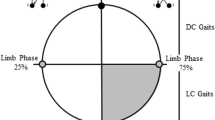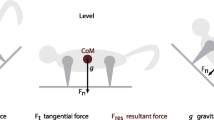Abstract
Sloths are morphologically specialized in suspensory quadrupedal locomotion and posture. During steady-state locomotion they utilize a trot-like footfall sequence. Contrasting the growing amount of published accounts of the functional morphology and kinematics of sloth locomotion, no study concerned with the dynamics of their quadrupedal suspensory locomotion has been conducted. Brachiating primates have been shown to travel at low mechanical costs using pendular mechanics, but this is associated with considerable dynamic forces exerted onto the support. To test whether sloth locomotion can be described by simple connected pendulum mechanics, we analyzed the dynamics of sloth locomotion with use of a mechanical segment link model. The model integrates the body segment parameters and is driven by kinematic data with both segment parameters and kinematic data obtained from the same sloth individual. No simple pendular mechanics were present. We then used the model to carry out an inverse dynamic analysis. The analysis allowed us to estimate net limb joint torques and substrate reaction forces during the contact phases. Predominant flexing limb joint torque profiles in the shoulder, elbow, hip, and knee are in stark contrast to published dominant extensor torques in the limb joints of pronograde quadrupedal mammals. This dissimilarity likely reflects the inverse orientation of the sloth towards the gravity vector. Nevertheless, scapular pivot and shoulder seem to provide the strongest torque for progression as expected based on unchanged basic kinematic pattern previously described. Our model predicts that sloths actively reduce the dynamical forces and moments that are transmitted onto the support. We conclude that these findings reflect the need to reduce the risk of breaking supports because in this case sloths would likely be unable to react quickly enough to prevent potentially lethal falls. To achieve this, sloths seem to avoid the dynamical consequences of effective pendular mechanics.






Similar content being viewed by others
References
Andrada E, Mämpel J, Schmidt A, Fischer MS, Karguth A, Witte H (2010) Biomechanical analyses of rat locomotion during walking and climbing as a base for the design and construction of climbing robots. In: Brebbia CA, Carpi A (eds) Design & nature V: comparing design in nature with science and engineering. WIT Press, Southampton, pp 165–177
Ashton EH, Oxnard CE (1964) Locomotor patterns in primates. Proc Zool Soc, Lond 142:1–28
Bertram JEA, Chang YH (2001) Mechanical energy oscillations of two brachiating gaits: measurement and simulation. Am J Phys Anthropol 115:319–326
Biewener AA (2006) Patterns of mechanical energy change in tetrapod gait: pendula, springs and work. J Exp Zool 305A:899–911
Britton SW (1941) Form and function in the sloth. The Quarterly Review of Biology 16(1):13–34
Cartmill M (1985) Climbing. In: Hildebrand M, Bramble DM, Liem KF, Wanke DB (eds) Functional vertebrate morphology. The Belknap Press of Harvard University Press, Cambridge, London, pp 73–88
Cavagna GA, Thys H, Zamboni A (1976) The sources of external work in level walking and running. J Physiol 262:639–657
Chang YH, Bertram JEA, Lee DV (2000) External forces and torques generated by the brachiating white-handed gibbon (Hylobates lar). Am J phys Anthropol 113:201–216
Clayton HM, Lanovaz JL, Schamhardt HC, Willemen MA, Colborne GR (1998) Net joint moments and powers in the equine forelimb during the stance phase of the trot. Equine Vet J 30:384–389
Cohen AH, Gans C (1975) Muscle activity in rat locomotion: movement analysis and electromyography of the flexors and extensors of the elbow. J Morphol 146:177–196
Demes B, Jungers WL, Nieschalk U (1990) Size- and speed related aspects of quadrupedal walking in slender and slow lorises. In: Jouffroy FK, Stack MH, Niemitz C (eds) Gravity, posture, and locomotion in primates. II Sedicesimo, Firence, pp 175–197
Demes B, Larson SG, Stern JT, Jungers WL, Biknevicius AR, Schmitt D (1994) The kinetics of primate qadrupedalism: “hindlimb drive” reconsidered. J Hum Evol 26:353–374
Dogan S, Manley PA, Vanderby R, Kohles SS, Hartman LM, BcBeath AA (1991) Canine intersegmental hip joint forces and moments before and after cemented total hip replacement. J Biomech 28:753–758
Fischer MS (1994) Crouched posture and high fulcrum, a principle in the locomotion of small mammals: the example of the rock hyrax (Procavia capensis) (Mammalia: Hyracoidea). J Hum Evol 26:501–524
Fischer MS, Lehmann R (1998) Application of cineradiography for metric and kinematic study of in-phase gaits during locomotion of the pika (Ochotona rufescens, Mammalia: Lagomorpha). Zoology 101:148–173
Fischer MS, Schilling N, Schmidt M, Haarhaus D, Witte H (2002) Basic limb kinematics of small therian mammals. J Exp Biol 205:1215–1338
Fleagle JG (1974) Dynamics of a brachiating siamang [Hylobates (Symphalangus) syndactylus]. Nature 248:259–260
Fleagle JG (1976) Locomotion and posture of the Malayan Siamang and implications for hominoid evolution. Folia Primatol 26:245–269
Fowler EG, Gregor RJ, Hodgson JA, Roy RR (1993) Relationship between ankle muscle and joint kinetics during the stance phase of locomotion in the cat. J Biomech 26:465–483
Fujiwara SI, Endo H, Hutchinson JR (2011) Topsy-turvy locomotion: biomechanical specializations of the elbow in suspended quadrupeds reflect inverted gravitational constraints. J Anat 219:176–191
Geissmann T (2003) Vergleichende Primatologie. Springer, Berlin, pp 1–357
Goslow GE, Seeherman HJ, Taylor CR, McCutchin MN, Heglund NC (1981) Electrical activitiy and relative length changes of dog limb muscles as a function of speed and gait. J Exp Biol 94:15–42
Grand TI (1972) A mechanical interpretation of terminal branch feeding. J Mammal 53:198–201
Ishida H, Jouffroy FK, Nakano Y (1990) Comparative dynamics of pronograde and upside down horizontal quadrupedalism in the slow loris (Nyctecebus coucang). In: Jouffroy FK, Stack MH, Niemitz C (eds) Gravity, posture and locomotion in primates. Editrice Il Sedicesimo, Firenze, pp 209–220
Jenkins FA, Weijs WA (1979) The functional anatomy of the shoulder in the Virginia opossum (Didelphis virginiana). J Zool Lond 188:379–410
Jouffroy FK, Stern JT (1990) Telemetered EMG study of the antigravity versus propulsive actions of knee and elbow muscles in the slow loris. In: Jouffroy FK, Stack MH, Niemitz C (eds) Gravity, posture and locomotion in primates. Editrice Il Sedicesimo, Firenze, pp 209–220
Jungers WL, Stern JT (1980) Telemetered electromyography of forelimb muscle chains in gibbons (Hylobates lar). Science 208:617–619
Jungers WL, Stern JT (1981) Preliminary electromyographical analysis of brachiation in gibbon and spider monkey. Int J Primatol 2:19–33
Kummer B (1970) Die Beanspruchung des Armskeletts beim Hangeln. Ein Beitrag zum Brachiatorenproblem. Anthropol Anz 32:74–82 (in German)
Kuznetsov AN (1985) Comparative functional analysis of the fore- and hindlimbs in mammals. Zool J Moscow 64:1862–1867 (in Russian)
Mendel FC (1979) The wrist joint of two-toed sloths and its relevance to brachiating adaptations in the Hominoidea. J Morphol 162:413–424
Mendel FC (1981a) Foot of two-toed sloths: its anatomy and potential uses to size of support. J Morphol 170:357–372
Mendel FC (1981b) The hand of two-toed sloths (Choloepus): its anatomy and potential uses relative to size of support. J Morphol 169:1–19
Mendel FC (1981c) Use of hands and feet of two-toed sloths (Choloepus hoffmanni) during climbing and terrestrial locomotion. J Mamm 62:413–421
Mendel FC (1985a) Adaptations for suspensory behavior in the limbs of two-toed sloths. In: Montgomery GG (ed) The evolution and ecology of armadillos, sloths, and vermilinguas. Smithonian Institution Press, Washington, pp 151–162
Mendel FC (1985b) Use of hands and feet of the three-toed sloth (Bradypus variegatus) during climbing and terrestrial locomotion. J Mammal 62:359–366
Michilsens F, Vereecke EE, D’Août K, Aerts P (2009) Functional anatomy of the gibbon forelimb: adaptations to a brachiating lifestyle. J Anat 215:335–354
Michilsens F, Vereecke EE, D’Août K, Aerts P (2010) Muscle moment arms and function of the siamang forelimb during brachiation. J Anat 217:521–535
Miller RA (1935) Functional adaptations in the forelimb of the sloths. J Mammal 16:38–51
Nyakatura JA (2012) The convergent evolution of suspensory posture and locomotion in tree sloths. J Mamm Evol 19:225–234
Nyakatura JA, Fischer MS (2010a) Three dimensional kinematic analysis of the pectoral girdle during upside-down locomotion of the two-toed sloth (Choloepus didactylus, Xenarthra). Front Zool 7: Art No 21
Nyakatura JA, Fischer MS (2010b) Functional morphology and three-dimensional kinematics of the thoraco-lumbar region of the spine of the two-toed sloth. J Exp Biol 213:4278–4290
Nyakatura JA, Fischer MS (2011) Functional morphology of the muscular sling at the pectoral girdle in tree sloths: convergent morphological solutions to new functional demands? J Anat 219:360–374
Nyakatura JA, Petrovitch A, Fischer MS (2010) Limb kinematics during locomotion in the two-toed sloth (Choloepus didactylus, Xenarthra) and its implications for the evolution of the sloth locomotor apparatus. Zoology 213:221–234
Pandy MG, Kumar V, Berme N, Waldron KJ (1988) The dynamics of quadrupedal locomotion. J Biomech Eng 110:230–237
Peterson JA (1984) The locomotion of Chameleo (Reptilia: Sauria) with particular reference to the forelimb. J Zool Lond 202:1–42
Preuschoft H (1973) Functional anatomy of the upper extremity. In: Bourne GH (ed) The chimpanzee, vol. 6. Karger Verlag, Basel, pp 34–120
Preuschoft H, Demes B (1984) Biomechanics of brachiation. In: Preuschoft H, Chivers DJ, Brockelman WY, Creel N (eds) The lesser apes: evolutionary and behavioural biology. Edinburgh Unversity Press, Edinburgh, pp 96–118
Schmidt M (2005) Quadrupedal locomotion in squirrel monkeys (Cebidae: Saimiri sciureus)—a cineradiographic study on limb kinematics and related substrate reaction forces. Am J Phys Anthropol 128:359–370
Schmitt D (1999) Compliant walking in primates. J Zool Lond 248:149–160
Schoonaert K, D’Août K, Aerts P (2006) A dynamic force analysis system for climbing in large primates. Folia Primatol 77:246–254
Stevens NJ, Schmitt DO, Cole TM, Chan LK (2006) Technical note: out-of-plane angular correction based on a trigonometric function for use in two-dimensional kinematic studies. Am J Phys Anthropol 129:399–402
Strauss WL, Wislocki GB (1932) On certain similarities between sloths and slow lemurs. Bull Mus Comp Zool Harv Coll 74:45–56
Swartz SM (1989) Pendular mechanics and the kinematics and energetics of brachiating locomotion. Int J Primatol 10:387–418
Thorup VM, Laursen B, Jensen BR (2008) Net joint kinetics in the limbs of pigs walking on concrete floor in dry and contaminated conditions. J Anim Sci 86:992–998. doi:10.2527/jas.2007-0581 originally published online Dec 21, 2007
Turnquist JE, Schmitt D, Rose MD, Cant JGH (1999) Pendular motion in the brachiation of captive Lagothrix and Ateles. Am J Primatol 48:263–281
Vinyard CJ, Schmitt D (2004) New technique for studying reaction forces during primate behaviours on vertical substrates. Am J Phys Anthropol 125:343–351
Vassal PA, Jouffroy FK, Lessertisseur J (1962) Musculature de la main et du pied du Paresseux Ai (Bradypus tridactylus L.). Folia Clinica et Biologica 31:142–153 (in French)
Witte H, Biltzinger J, Hackert R, Schilling N, Schmidt M, Reich C, Fischer MS (2002) Torque patterns of the limbs of small therian mammals during locomotion on flat ground. J Exp Biol 205:1339–1353
Acknowledgments
The authors would like to thank Dirk Arnold for his assistance during dissections of sloth cadavers and Rommy Petersohn, Sabine Moritz, and Lydia Wagner for assistance during the kinematic analysis. We also want to thank Holger Preuschoft for insightful discussion. Two reviewers' comments helped to improve an earlier version of the manuscript. Lucy Cathrow thoroughly edited the language.
Author information
Authors and Affiliations
Corresponding author
Additional information
Communicated by: Jan M. Wójcik
Rights and permissions
About this article
Cite this article
Nyakatura, J.A., Andrada, E. A mechanical link model of two-toed sloths: no pendular mechanics during suspensory locomotion. Acta Theriol 58, 83–93 (2013). https://doi.org/10.1007/s13364-012-0099-4
Received:
Accepted:
Published:
Issue Date:
DOI: https://doi.org/10.1007/s13364-012-0099-4




